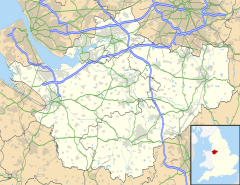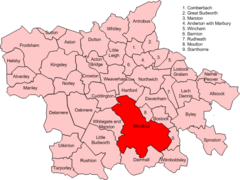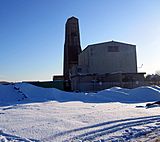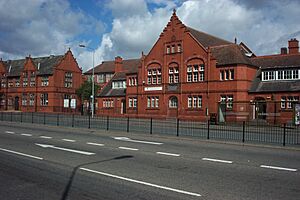Winsford facts for kids
Quick facts for kids Winsford |
|
|---|---|
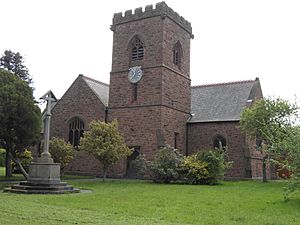 Christ Church, Wharton, Winsford |
|
| Population | 35,500 (2024 estimate) |
| OS grid reference | SJ6566 |
| • London | 155 mi (249 km) SE |
| Civil parish |
|
| Unitary authority |
|
| Ceremonial county | |
| Region | |
| Country | England |
| Sovereign state | United Kingdom |
| Post town | WINSFORD |
| Postcode district | CW7 |
| Dialling code | 01606 (Northwich/Winsford), 01829 (Tarporley) |
| Police | Cheshire |
| Fire | Cheshire |
| Ambulance | North West |
| EU Parliament | North West England |
| UK Parliament |
|
| Website | www.winsford.gov.uk |
Winsford is a town in Cheshire, England. It sits by the River Weaver, south of Northwich. Winsford grew because of its salt mining industry. In the 1700s, the river was made deeper for boats. This helped transport goods, especially salt, to the River Mersey. Today, Winsford has about 35,500 people.
Winsford is divided into three main areas. These are Over, on the west side of the River Weaver, Wharton on the east side, and Swanlow and Dene.
Contents
Winsford's History
How Winsford Began
Winsford was once three old parishes: St Chads, Over, and Wharton. These areas joined together in the 1800s. The name "Winsford" might come from "Wain's" or "Wynne's ford." This means it was "Mr. Wain's crossing point" over the River Weaver.
The Norman Earls of Chester had a hunting lodge at Darnhall, in Over parish. This was a special area where deer and wild boar were kept for hunting. King Henry III later owned these lands. In 1270, he gave the estate to a group of monks called Cistercians.
The monks started building Darnhall Abbey in 1274. But the land was not good for their big plans. So, in 1281, they moved to build Vale Royal Abbey in Whitegate.
In 1280, King Edward I allowed the Abbey to hold a market and a fair in Over. This is how the market in Winsford started, and it still happens today.
Winsford Grows Bigger
Winsford started to grow a lot after 1721. This was when the government allowed changes to the River Weaver. Locks were built, letting large ships reach Winsford from Liverpool. At first, this was the closest barges could get to the Staffordshire Potteries. These barges carried china clay from Cornwall.
Local salt was also sent to the Potteries. It was used to make salt-glazed pots. Finished pottery then came back to Winsford. From there, it was shipped out through Liverpool. This trade stopped in the 1780s when the Trent and Mersey Canal opened. This new canal bypassed Winsford. The improved River Weaver even inspired the Bridgewater Canal.
Trains came to Winsford quite early. Winsford station opened in 1837. It was part of the Grand Junction Railway.
From the 1830s, salt became very important to Winsford. Salt mines in Northwich began to collapse. So, a new source of salt was needed near the River Weaver. Winsford had this new source. This led to many salt factories being built along the river.
A new town grew about 1 mile (1.5 km) from the old area of Over. Most of the new buildings were on the other side of the river. New homes, shops, pubs, and churches were built in Wharton. Many buildings from the 1800s used timber frames. This was because of the risk of the ground sinking due to salt mining.
Winsford Urban District Council started in 1894. It managed the areas of Over and Wharton.
Winsford in the 1900s
By the Second World War, fewer people worked in the salt trade. One company took over all the salt works. They used new methods that needed less labor.
Old, poor-quality homes were replaced starting in the 1930s. By the 1950s, three new housing areas were built. In the 1960s, Winsford was still mostly terraced houses.
The town grew a lot in the late 1960s and 1970s. It was chosen to take people moving from Liverpool. This meant new industrial areas were built. There were also new council and private homes. A new shopping center was added with a library, sports center, and doctors' offices. However, the town's population did not grow as much as planned. So, some new buildings were too big.
Vale Royal Borough Council was formed in 1974. It covered Winsford, Northwich, and nearby rural areas. In 1991, the council moved its main office to Winsford. Since 2009, this building has been used by Cheshire West and Chester Council. Winsford Town Council is also in this building. Later, both the Cheshire Fire Service (1997) and Cheshire Police (2003) moved their main offices to Winsford from Chester.
Local Government
Winsford's Location and Weather
| Weather chart for Winsford | |||||||||||||||||||||||||||||||||||||||||||||||
|---|---|---|---|---|---|---|---|---|---|---|---|---|---|---|---|---|---|---|---|---|---|---|---|---|---|---|---|---|---|---|---|---|---|---|---|---|---|---|---|---|---|---|---|---|---|---|---|
| J | F | M | A | M | J | J | A | S | O | N | D | ||||||||||||||||||||||||||||||||||||
|
69
6
1
|
50
7
1
|
60
9
3
|
50
12
4
|
60
15
7
|
66
18
10
|
66
20
12
|
79
20
12
|
74
17
10
|
76
14
8
|
79
9
4
|
79
7
2
|
||||||||||||||||||||||||||||||||||||
| temperatures in °C precipitation totals in mm source: |
|||||||||||||||||||||||||||||||||||||||||||||||
|
Imperial conversion
|
|||||||||||||||||||||||||||||||||||||||||||||||
A small part of southern Winsford is in the Weaver Valley Area of Special County Value.
Winsford's Weather
Winsford has a mild climate. Temperatures are usually a bit warmer than the UK average. It also gets a bit more sunshine. The amount of rain is slightly less than the UK average. Snow rarely stays on the ground for long, but there are some frosty days.
Economy and Jobs
Salt Mining in Winsford
Winsford has the largest rock salt mine in the UK. It's one of only three places in the UK where rock salt is mined.
Rock salt formed here 220 million years ago. This was during the Triassic period. Seawater flowed inland, creating shallow salt lakes. As the water dried up, thick layers of rock salt were left behind.
Mining started in Winsford in the 1600s. At first, it was used for animal salt licks. In 1844, Winsford Rock Salt Mine opened. Its owner, Salt Union Ltd., says it's "Britain's oldest working mine." Today, salt is dug from over 150 meters deep. This salt is used to de-ice roads in winter. The mine produces one million tons of salt each year. It has over 160 miles (257 km) of tunnels. These tunnels spread out under Winsford and Northwich.
A part of the mine that is no longer used for salt is now a storage facility. DeepStore Ltd. uses it to store important records. Government files, hospital records, and old archives are kept here. The mine's dry and stable air is perfect for keeping documents safe for a long time.
Shopping in Winsford
Winsford has several supermarkets. Asda and Aldi are in the town center. Morrisons, Home Bargains, and Co-op are in Wharton. Tesco is in Over. You can also find branches of many national chain stores. The main shopping center was built in the 1970s.
The Jiffy Bag is traditionally made in Winsford. It is sold to packaging companies, shops, and post offices.
Important Services
BT has a large office in Winsford. The Winsford telephone exchange is a key point for phone and internet services. It provides fibre broadband to Winsford and many nearby towns. It also connects important services like the police headquarters and hospitals.
The National Grid has a power station in Winsford. It provides electricity to about 25,000 homes in Winsford and Middlewich.
An aqueduct from Lake Vyrnwy brings water to Winsford. A large pumping station on Woodford Lane West supplies water to Winsford, Middlewich, and southern Northwich.
Famous Places in Winsford
St Chad's Church
St Chad's Church, on Swanlow Lane, is a very old landmark. A local story says it was first built in Over Square. But the devil was angry and tried to fly away with it. Monks at Vale Royal Abbey saw him and rang their bells. This made the devil drop the church where it is now. The church is a Grade II* listed building.
Stone (or 'Saxon') Cross
Near St John's Church of England Primary School is a unique old building. It was built in the 1800s. It looks like a pyramid with steps and a cross on top. It used to be a lock-up, a small jail. The door was blocked up in the 1970s.
Many made-up stories are told about this cross. People say there's buried treasure or secret passages. But these stories are not true. The street name Saxon Crossway was made up in the 1960s. The real Saxon cross is kept at St Chad's Church.
Winsford Flashes
The Winsford Flashes are the town's most special natural feature. They are sometimes called the "Cheshire Broads," like the famous Norfolk Broads. "Flash" is an old English word for "lake." The Winsford Flashes are three lakes along the River Weaver. They cover about 200 acres (80 hectares).
These lakes formed in the 1800s. The ground sank into empty spaces underground. These spaces were left after salt was dissolved and washed out. As the ground sank, the River Weaver became wider, forming lakes where farmland used to be.
In the late 1800s, the Winsford Flashes became popular. People from nearby cities like Manchester came for day trips. They enjoyed boating, picnics, and sightseeing.
However, the Flashes were never fully developed for visitors. Their popularity soon faded. Today, local people enjoy them for sailing, fishing, and walking. They are home to many types of wildlife. Migratory birds like Canada geese spend winter here.
Other Landmarks to See
St John's Church on Delamere Street was built in 1863. Lord Delamere of Vale Royal had it built to remember his wife. Its tall spire can be seen for miles around.
The Brunner Guildhall now houses the Citizens Advice Bureau. It was built in the late 1800s. It was given to Winsford Urban District Council by Sir John Tomlinson Brunner. It was meant for public use.
Parts of the Knights Grange pub were built in the 1600s. It was once a farmhouse belonging to Vale Royal Abbey.
Littler Grange is now a children's nursery. It is the best old half-timbered building in Winsford. It even has sloping floors upstairs.
Dawk House on Swanlow Lane is an old timber-framed farm. It was covered in white plaster around 1711.
The Blue Bell Inn, near St Chad's Church, is also a children's nursery now. It is a copy of an old medieval building that burned down in the 1960s.
Getting Around Winsford
Winsford railway station is about one mile (1.5 km) east of the town center. It is on the main train line from Liverpool to Birmingham. Winsford once had two other train stations.
The M6 motorway is the closest major road. You can reach it at junction 18 near Middlewich. The A54 road connects Winsford to the motorway.
The closest airports are Liverpool John Lennon Airport and Manchester Airport.
Winsford has a bus network. Buses travel to Crewe and Northwich.
Education in Winsford
Fourteen schools in Winsford work together. They are part of the Winsford Education Partnership. They share resources and plan together.
Primary Schools
- Darnhall Primary School
- Grange Primary School
- Oak View Academy
- Winsford High Street Community Primary School
- Overhall Primary School
- St. Chad's C of E Primary School
- St. Joseph's Roman Catholic Primary School
- Wharton CofE Infant and Junior School
- Willow Wood Community Primary School
- Over St Johns CofE Primary School
Secondary Schools
- The Winsford Academy: This school was formed in 2010 by joining Verdin High School and Woodford Lodge High School.
- Hebden Green Community School
- Oaklands School
Colleges
- Warrington and Vale Royal College
Places of Worship
Many churches in Winsford are part of Winsford Churches Together. These include:
- Christ Church, Wharton, Crook Lane
- St Andrew's Methodist Church, Dingle Lane
- St Chad's Church, Over, off Swanlow Lane
- St John the Evangelist's Church, Winsford, Delamere Street
- St Joseph's Catholic Church, Woodford Lane
- The Salvation Army, Weaver Street
- Trinity Methodist Church, Station Road
- Over United Reformed Church, Over Square, Swanlow Lane
- River of Life Church, Queens Parade
- Living Waters Christian Fellowship, Dingle Centre and Queen's Parade
Sports and Fun in Winsford
The town has a local football team called Winsford United. They play at Barton Stadium. Famous goalie Neville Southall once played for them.
In 2019, Winsford was chosen for a new £70 million Cheshire FA Centre of Excellence. This will be the new home for the England Women's Football Team. It will also be a training base for European teams.
Winsford ASC is a swimming club. They have won the North West Division 1 speedo league.
Vale Royal Athletic Club is based in Northwich and Winsford. Many international athletes train with them. This club was formed in 1994.
Winsford has youth football teams like Winsford Junior Blues.
Winsford Cricket Club has played cricket since 1888. They play in the Meller Braggins Cheshire Cricket League.
Allotment gardens at Moss Bank, Over, started in 1924. People can rent small plots of land to grow their own food. In the late 1980s, a giant pumpkin weighing 579 lb (263 kg) was grown here. It held the national record for a while!
Winsford Flash Sailing Club is on Bottom Flash, the largest of the town's lakes. The club started in 1931.
The Brighton Belle pub used to be called the Railway Inn. In 1972, a special train carriage from the Brighton Belle train was added to be a restaurant. This carriage became a local landmark until it was removed in 1998.
Famous People from Winsford
- John Bishop (born 1966), a comedian, grew up partly in Winsford.
- Sir John Bradbury, 1st Baron Bradbury (1872–1950), a British government official, was born in Winsford.
- Clare Calbraith (born 1974), an actress, was born in Winsford.
- James Clarke (1894–1947), who received the Victoria Cross in World War I, was born in Winsford.
- Simon Davies (born 1974), a footballer, was born in Winsford.
- Daniel Fox (born 1986), a footballer, was born in Winsford.
- David Hanson (born 1957), a politician, went to school in Winsford.
- Sandy MacIver (born 1998), a footballer, was born in Winsford.
- Nicky Maynard (born 1986), a footballer, was born in Winsford.
- Alan Oakes (born 1942), a footballer and manager, was born in Winsford.
- Glyn Pardoe (1946–2020), a footballer, was born in Winsford.
- Gertrude Maud Robinson (1886–1954), an organic chemist, was born in Winsford.
- The Luka State, a British rock group.
Twin Town
Winsford is twinned with:
- Deuil-la-Barre, France (since 1993).
Winsford also has a friendly connection with:
- Nieder-Eschbach, Germany, which is also twinned with Deuil-la-Barre.
See also
 In Spanish: Winsford para niños
In Spanish: Winsford para niños


